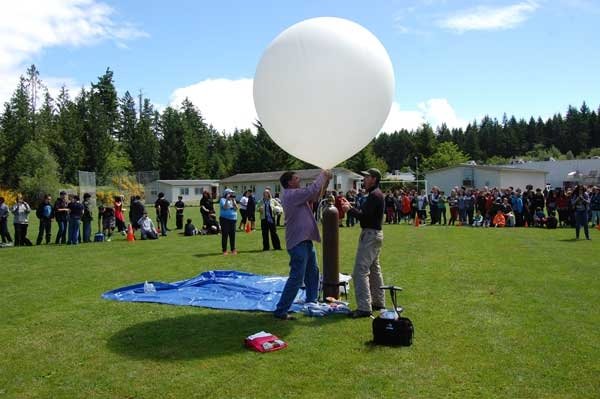 Key Peninsula Middle School teacher Richard Miller, left, and parent volunteer Ed Bressette ready the project balloon (and egg) with some 160 cubic feet of helium moments before its May 31 maiden flight. Photo courtesy Richard Miller
Key Peninsula Middle School teacher Richard Miller, left, and parent volunteer Ed Bressette ready the project balloon (and egg) with some 160 cubic feet of helium moments before its May 31 maiden flight. Photo courtesy Richard Miller
The eighth grade science class at Key Peninsula Middle School launched a commercial weather balloon at 11:30 a.m. on Friday, May 31.
It traveled 217 miles, cross-country, landing 20 miles north of Pasco, Wash., about 5:30 p.m. that same day. The total flight time was five hours and 42 minutes.
The Seattle FAA Center tracked the balloon and confirmed an altitude of 40,000 feet before it lost telemetry. Leon Fullner from the FAA said it “was the best telemetry on this type of weather balloon that we have ever seen.”
Pilots were advised by the FAA to keep an eye out for the balloon. Pilots from two different airliners flying at 40,000 feet reported seeing the balloon traveling “well above 40,000 feet altitude.”
The last telemetry received from the balloon reported 109,000 for altitude, which has not been verified.
An on-board radio broadcast provided a record of altitude, speed, GPS location and a continuous video before the battery power died.
The balloon started out at a sedate 15 to 20 mph at about 12,000 feet. When it passed into the jet stream at 40,000 feet, it rapidly accelerated to 110 mph.
The ground-bound recovery team made up of the “mission controller” (team leader) Sky Bressette and his father Ed Bressette, left KPMS by car a half-hour after launch. They were pulled over only once for speeding.
Telemetry was lost when the recovery team was near Mount Rainier, so they continued on the “projected” flight path, later regained the radio signal when the balloon burst at altitude, and arrived at the recovery sight 20 minutes after touchdown in a farmer’s field next to the highway.
The flight path and recovery site were “right on” the projections calculated from wind measurements and computer models provided by NOAA.
According to the science teacher, Richard Miller, the computer projections showed that with a full load of helium gas, the balloon would not have made it past Mount Rainier. At a full load, the gas would have expanded the balloon diameter from 6 -7 feet to 30 -40 feet, bursting the balloon in the thin air at 89,000 feet.
“We undercharged the balloon, instead, using less helium, which allowed for the greater altitude and range obtained,” Miller said. “Later this month we will launch again with a full load and see what we get.
“A raw egg that the class named ‘Phil’ was the only passenger in the balloon,” said Miller. “At 700 feet, Phil the egg was separated from the balloon for a free -all drop to the ground, which Phil survived intact, setting what we believe to be a Guinness World Record for highest egg drop.”
Ten minutes of edited flight video can be seen on YouTube, where it will remain accessible for as long as Google stays in business.
A program manager from CNN World News saw the YouTube video and immediately phoned Miller for a contract allowing CNN to broadcast clips from the YouTube program over CNN affiliates worldwide.
“The modest sum coming from CNN will help a lot to purchase a second video camera for our next launch,” Miller said.
For the next flight, the balloon team wants to include a second video camera, along with more batteries for longer camera life, and overinflate the balloon for a shorter flight time.
Miller’s 2012-13 aerospace class included 28 students who all contributed to the balloon project.
KPMS balloon flight No. 2
At 1:30 p.m. on June 15, the KPMS aerospace science class launched its second weather balloon from the town of Ashford, near Mount Rainier. An altitude of 91,000 feet was verified before it was recovered the following day, June 16, near Duvall, Wash.
“Our plan was to launch the balloon from within Mount Rainier National Park, where it would travel directly over Mount Rainier,” said science teacher Richard Miller. “We had obtained FAA approval, but a park ranger would not let us launch because we did not obtain prior approval from the park.”
After launching near Ashford, the three-person recovery team tracked and followed the balloon using telemetry broadcast from the balloon and GPS data received from satellites on their laptop computers.
“The flight path followed exactly what had been projected. The balloon travelled due north and burst at 91,000 feet, coming to rest in a large tract of timberland, 20 miles from the nearest public road, north of Snoqualmie, east of Duvall and south of Monroe,” Miller said.
“The following morning, the recovery team was lucky to find somebody who could open the chained-off primitive logging tracks, allowing the team to drive (very slowly) to the recovery site.”
Phil the egg survived intact, along with all of the instruments and cameras.[/box]
UNDERWRITTEN BY THE FUND FOR NONPROFIT NEWS (NEWSMATCH) AT THE MIAMI FOUNDATION, THE ANGEL GUILD, ADVERTISERS, DONORS AND PEOPLE WHO SUPPORT INDEPENDENT, NONPROFIT LOCAL NEWS